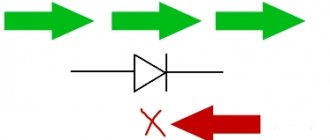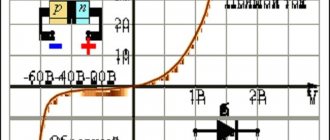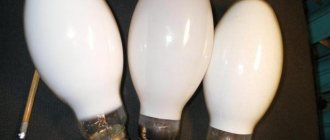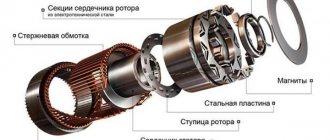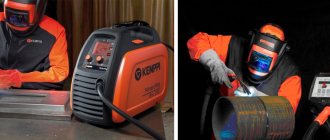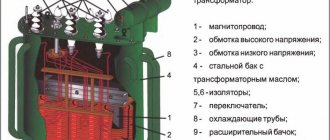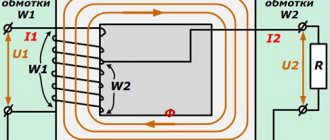Operating principle
The necessary effect during operation of the device is created by the features of the pn junction. They consist in the fact that a layer is built near the junction of two semiconductors, which is characterized by two points: high resistance and the absence of charge carriers. Further, when this barrier layer is exposed to alternating voltage from the outside, its thickness decreases and subsequently disappears. The current that increases during this is the direct current that passes from the anode to the cathode. If the polarity of the external alternating voltage changes, the blocking layer will be larger and the resistance will inevitably increase.
The current-voltage characteristic of the rectifier diode (volt-ampere characteristic) also gives an idea of the specifics of the rectifier’s operation and is nonlinear. It looks like this: there are two branches - forward and reverse. The first reflects the highest conductivity of the semiconductor when a direct potential difference occurs. The second indicates the value of low conductivity at an inverse potential difference.
The current-voltage characteristics of the rectifier are directly proportional to the temperature, with an increase in which the potential difference decreases. Electric current will not pass through the device in the case of low conductivity, but an avalanche breakdown occurs if the reverse voltage increases to a certain level.
General information
Diode (D) is a semiconductor element that serves to pass current through a pn junction in only one direction. With the help of D, you can straighten the variable U, obtaining a constant pulsating one from it. To smooth out ripples, capacitor or inductive filters are used, and sometimes they are combined.
D consists only of a pn junction with leads called anode (+) and cathode (-). Current, when passing through a conductor, has a thermal effect on it. When heated, the cathode emits negatively charged particles - electrons (E). The anode attracts electrons because it has a positive charge. In the process, an emission field is formed, in which a current (emission) occurs. Between (+) and (-) a negative spatial charge is generated, which interferes with the free movement of electrons. Electrons that reach the anode form an anodic current, and those that do not reach the cathode. If the anode and cathode currents are zero, D is in the closed state.
Semiconductor device
D consists of a housing made of durable dielectric material. The housing contains a vacuum space with 2 electrodes (anode and cathode). Electrodes representing a metal with an active layer are indirectly heated. The active layer emits electrons when heated. The cathode is designed in such a way that there is a wire inside it that glows and emits electrons, and the anode serves to receive them.
Figure 1 - Schematic representation of a pn-type semiconductor.
Areas of application
D is widely used as an AC rectifier in the construction of power supplies (PSUs), diode bridges, and also as a single element of a specific circuit. D is able to protect the circuit from non-compliance with the polarity of the power source connection. A breakdown of any semiconductor part (for example, a transistor) may occur in the circuit and lead to the process of failure of the chain of radio elements. In this case, a chain of several D connected in the opposite direction is used. Switches are created based on semiconductors for switching high-frequency signals.
D are used in the coal and metallurgical industries, especially when creating intrinsically safe switching circuits in the form of diode barriers that limit U in the required electrical circuit. Diode barriers are used together with current limiters (resistors) to reduce I values and increase the degree of protection, and therefore the electrical safety and fire safety of the enterprise.
Using an assembly
When operating a semiconductor diode rectifier, only half of the alternating current waves are useful, and more than half of the input voltage is therefore irretrievably lost.
In order to improve the quality of conversion of alternating current to direct current, an assembly of four devices is used - a diode bridge. It differs favorably in that it passes current during each half-cycle. Diode bridges are produced in the form of a kit enclosed in a plastic case.
Schematic diagram of a diode bridge
Physical and technical parameters
The main parameters of rectifier diodes are based on the following values:
- the maximum permissible value of the potential difference when rectifying the current, at which the device will not fail;
- the highest average rectified current;
- the highest reverse voltage value.
The industry produces rectifiers with different physical characteristics. Accordingly, the devices have different shapes and installation methods. They are divided into three groups:
- High power rectifier diodes. They are characterized by a current capacity of up to 400 A and are high-voltage. High-voltage rectifier diodes are produced in two types of packages - pin, where the case is sealed and glass, and tablet, where the case is made of ceramic.
- Medium power rectifier diodes. They have a capacity from 300 mA to 10A.
- Low power rectifier diodes. The maximum permissible current value is up to 300 mA.
Germanium or silicon
Based on the materials used, they are silicon and germanium, but silicon rectifier diodes are more widely used due to their physical properties.
Their reverse currents are several times less than in germanium ones, while the voltage is the same. This makes it possible to achieve very high permissible reverse voltages in semiconductors, which can be up to 1000-1500 V. In germanium diodes this parameter is in the range of 100-400 V.
Silicon diodes are able to remain operational in the temperature range from -60 ºС to +150 ºС, and germanium diodes - only from -60 ºС to +85 ºС. This happens because when the temperature rises above 85 ºС, the number of electron-hole pairs formed reaches such values that the reverse current sharply increases and the rectifier ceases to work effectively.
Selection of rectifier diodes
When purchasing a device, you must be guided by the following parameters:
- values of the current-voltage characteristic of the maximum reverse and peak current;
- maximum permissible reverse and forward voltage;
- average rectified current strength;
- device material and type of installation.
Depending on the physical characteristics, a corresponding designation is applied to the device body. A catalog with markings of rectifier diodes is presented in a specialized reference book. You need to know that the labeling of imported analogues differs from domestic ones.
It is also worth paying attention to the fact that rectifier circuits differ in the number of phases:
- Single-phase. Widely used for household electrical appliances. There are diodes for automobiles and for electric arc welding.
- Multiphase. Indispensable for industrial equipment, public and special transport.
Schottky diode
A special position is occupied by the Schottky diode. It was invented in connection with the growing needs in the developing radio electronics industry. Its main difference from other diodes is that its design includes a metal-semiconductor as an alternative to a pn junction. Accordingly, the Schottky diode has its own unique properties that silicon rectifier diodes cannot boast of. Some of them:
- operational renewability of the charge due to its low value;
- minimum voltage drop across the junction when connected directly;
- The leakage current is significant.
When making a Schottky diode, materials such as silicon and gallium arsenide are used, but germanium is also sometimes used. The properties of the materials are slightly different, but in any case, the maximum permissible reverse voltage for a Schottky rectifier is no more than 1200 V.
In contrast to all the advantages, the design of this type also has disadvantages. For example, in a bridge assembly, the device categorically does not perceive excess reverse current. Violation of the condition leads to breakdown of the rectifier. Also, a small voltage drop occurs at a low voltage of about 60-70 V. If the value exceeds this indicator, then the device turns into an ordinary rectifier.
It is worth noting that the advantages of a powerful Schottky rectifier diode significantly exceed the disadvantages.
Zener diode
To stabilize the voltage, a special device is used that can operate in breakdown mode - a zener diode, the foreign name of which is “Zener diode”. The device performs its function by operating in breakdown mode at a reverse bias voltage. The current increases at the moment of breakdown; at the same time, the differential value drops to a minimum, as a result of which the voltage is stable and covers a fairly serious range of reverse currents.
Marking of imported diodes
Currently, foreign-made SMD diodes are widely used. The design of the elements is made in the form of a board, on the surface of which a chip is fixed. The dimensions of the product are too small to allow marking to be applied to it. On larger elements, designations are present in full or abbreviated versions.
In electronics, SMD diodes make up about 80% of all products of this type used. Such a variety of details makes you pay more attention to the designations. Sometimes they may not coincide with the declared technical characteristics, so it is advisable to carry out additional checks of questionable elements if they are planned for use in complex and precise circuits. It should be borne in mind that the markings of diodes of this type may be different on completely identical cases. Sometimes there are only alphabetic symbols, without any numbers. In this regard, it is recommended to use tables with diode sizes from different manufacturers.
For SMD diodes, the SOD123 package type is most often used. A colored stripe or embossing may be applied to one of the ends, which indicates a cathode with negative polarity to open the pn junction. The only inscription corresponds to the designation of the case.
The type of housing does not play a decisive role when using a diode. One of the main characteristics is the dissipation of some amount of heat from the surface of the element. In addition, the values of the operating and reverse voltages, the maximum permissible current through the pn junction, power dissipation and other parameters are taken into account. All this data is indicated in reference books, and marking only speeds up the search for the desired element.
Practical use of rectifier diode
Due to the unstoppable development of scientific and technological progress, the use of rectifiers has affected all spheres of human activity. Power rectifier diodes are used in the following components and mechanisms:
- in power supplies for main engines of vehicles (land, air and water), industrial machines and equipment, drilling rigs;
- complete with diode bridge for welding machines;
- in rectifying installations for galvanic baths used for producing non-ferrous metals or applying a protective coating to a part or product;
- in rectifier installations for water and air purification, filters of various kinds;
- for transmitting electricity over long distances via high-voltage power lines.
In everyday life, rectifiers are used in various transistor circuits. Low-power devices are mainly used, both in the form of a half-wave rectifier and in the form of a diode bridge. For example, the diodes of the generator rectifier unit are well known to car enthusiasts.
